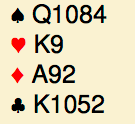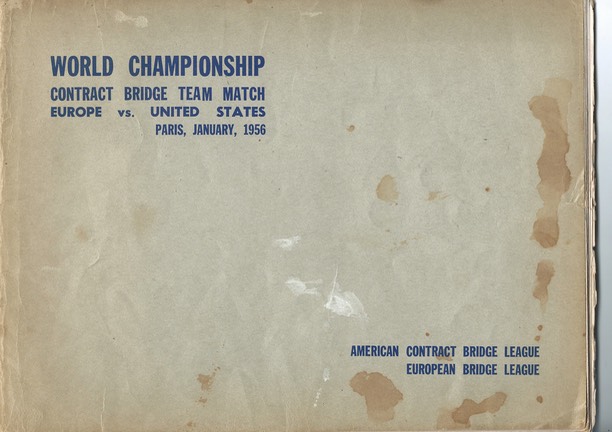Back from the junior to the senior world championships.

1st seat, white against red (not vulnerable against vulnerable), you pick up this rather average hand and open a weak (10-12) 1NT. Partner bids Stayman and passes your 2♠ rebid. Down 2, -100 against 2♥ making in the other direction for a wash. That doesn’t sound too interesting, doesn’t it? Well, the interesting part is the date that the hand was played: January 9, 1956 in the Bermuda Bowl match between France and the US. That’s right, mini-NT’s were already part of the game back then, so if you think that mini-NT’s are new, or that this was a Dutch invention of the mid 1970’s, time to adjust that. And if you are young and consider yourself modern, mini-NT’s aren’t a sign of that, your grandparents could have already played them.

I recently picked up an old copy of the 1956 World Championship book, reporting on the match between France (European champions in 1955) and the USA (represented by the winners of the 1955 Master teams). A few names must still sound familiar to today’s players: on the French side, there was Pierre Ghestem, well known for probably the most abused convention around. Also on the French side, Jais and Trezel, who later became the first players to win the triple: Bermuda Bowl, Olympiad and World Pair, and much later became involved in the cheating scandal that never made the headlines. The US team included Sam Stayman, known for the convention he never invented, and Charles Goren, Mr. Bridge in the 1950’s.
The report is actually a nice read, though the information is quite incomplete. It does list the auctions and the card led to the first 3 tricks. The rest of the play (quote) “may usually be judged from the final result” (unquote). We’ll see later that this does leave room for questions. The auctions also require some guesswork. The French pairs each did provide a 1 page write-up of their systems, which gives some information but still leaves lots of holes. For example, “the bid is 98% forcing”. This seems remarkably accurate but leaves the question which hands are in the 2% group. The Americans were shorter, the 6 players played in various line ups and listed 11 possible pairs (out of a possible 15) but the system descriptions for all pairs cover about 1/3 of a page in total. That includes a rather arrogant description of the system play by Goren and partners: “we play Goren Bridge Complete”. 5 words. And yes, the US players do complain about the lack of information from the French.
Besides the short descriptions, the bidding is also quite rough. It didn’t last long for the first redoubled contract to come up.
2NT was regular and strong, 3♣ Stayman. Sam Stayman saw that his convention had made it across the Atlantic and made a fairly dubious lead directing double. South tried to make a lead directing double as well and suddenly found out that he had to defend the contract. The opening lead was the ♣Q ducked to the ♣K. Declarer simply gave up 2 trumps to south. In the replay, north opened 1♥, east doubled for take-out and EW reached 4♠. With the same patterns in east and west, that contract cannot be made. 790 and 50 adds up to 840, or 7 EMP (European Match Points, or the forerunner of todays IMP’s).
This is a typical example of the rough bidding compared to today’s standards. Open the jump to 3♠ wastes a lot of bidding space and seems unnecessary as Sam Stayman’s own book lists 2♠ as forcing. 4♣ is listed as a cuebid but then I don’t understand why east didn’t cooperate. 5♥ is one of those bids which is impossible for partner to interpret, but here he does have everything west can be looking for: good hearts in context and a diamond control.
In the replay, things went a bit better but 4♣ is listed as Gerber and the 4♠ response (2 aces) seems to confirm that. West now has to guess, 6♥ is cold opposite the current hand, but switch the minors and it is down from the start.
This brings up another feature: psychics and mini-psychics. These are virtually unseen in todays game, but game up quite frequently back then. The biggest example:
South had no problem opening 1♥. And what is more surprising: EW had little trouble reaching 7NT after that, which is an accomplishment I’d think would not be easily repeated today when people take 1♥ seriously and don’t suspect a first hand psyche.
Of course, the chances that 1♥ would have backfired are a serious, just switch the 3 remaining hands around, but then again, never argue with success.
In the replay, EW bid 7♣, for a 2 EMP loss.
Of course, not all psyches worked, take for example board 152.
1♥ is between a psyche and a very light opening bid. Things got out of control after the redouble. Nowadays, one has to rebid 2♣ with the westhand to indicate a lack of interest in defending. If you don’t then one has accept partner’s double and hope for the best. NS are in fact already overboard, so it would have created a plus. But east got afraid of his own bidding and Pierre Jais must have thought that Christmas had come early in the year. Down 4, 700 in the old scoring. In the replay, EW made 2♥ which looks quite impossible but the play record is incomplete. Still 6 EMP to the French.
And finally a hand where having better play records would have helped.
Natural 1♣ and a game-forcing 2NT. Don’t ask me what the rest of the bids mean, but the final contract, played by east, is sound. South led a heart. Declarer won and played a club to ♣Q. Now the contract is cold (♣A, ♣, and later a diamond finesse), but it is still listed as down 1. In the replay, 6♣ was made, for 9 EMP’s.
While the boards themselves are quite exciting, the overall match was rather dull: 224 boards played in 12 and 14 board sessions, scored by EMP's or old-fashioned IMP’s (click here for details). The US team took an early lead after 40 boards of about 20 EMP’s. In the 4th session, the French turned the match around by scoring 40 unanswered EMP’s to lead by 20. The lead slowly increased to the final margin of a 54 EMP’s. That would be around 110 imp’s in todays world.
Bottom line: fun to read, but the game has evolved a lot over the past 60 years and this barely resembles todays game.
As usual, if you liked this blog, click on the ad below.
